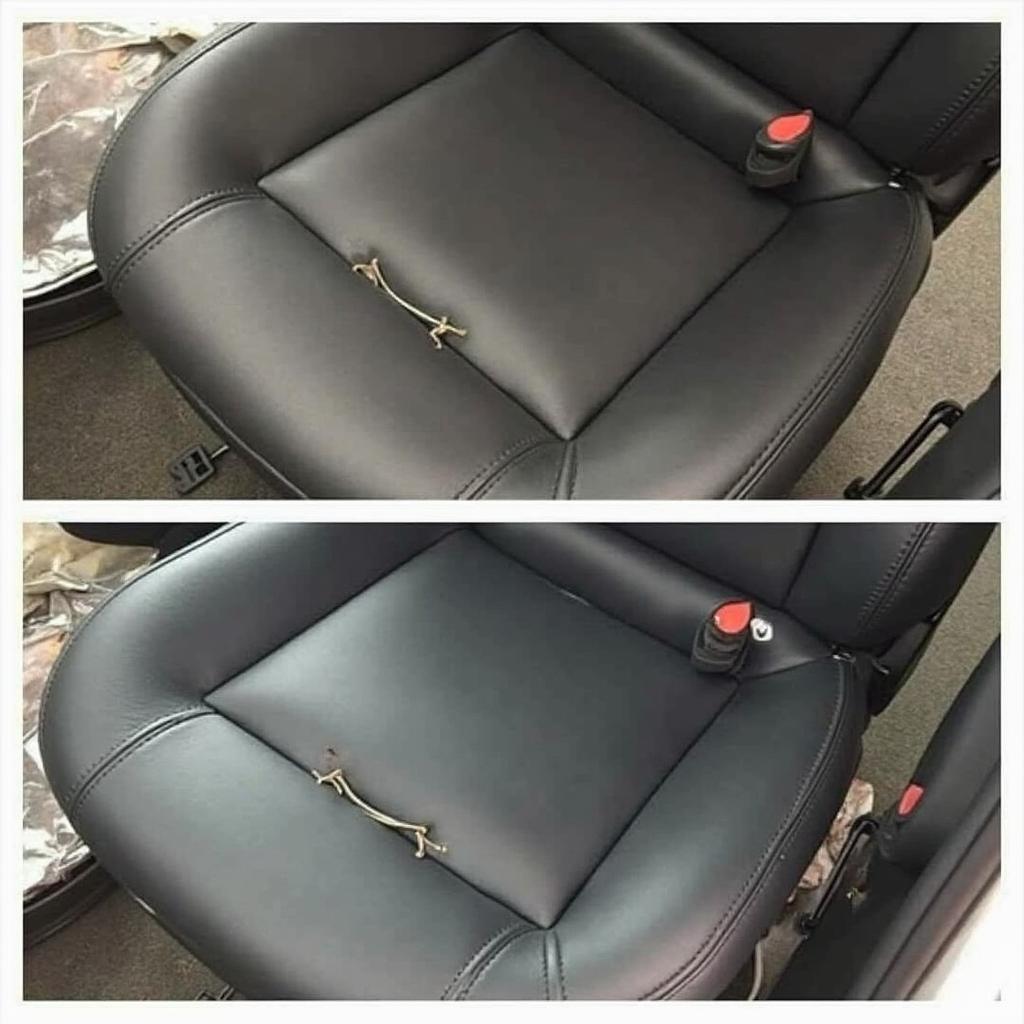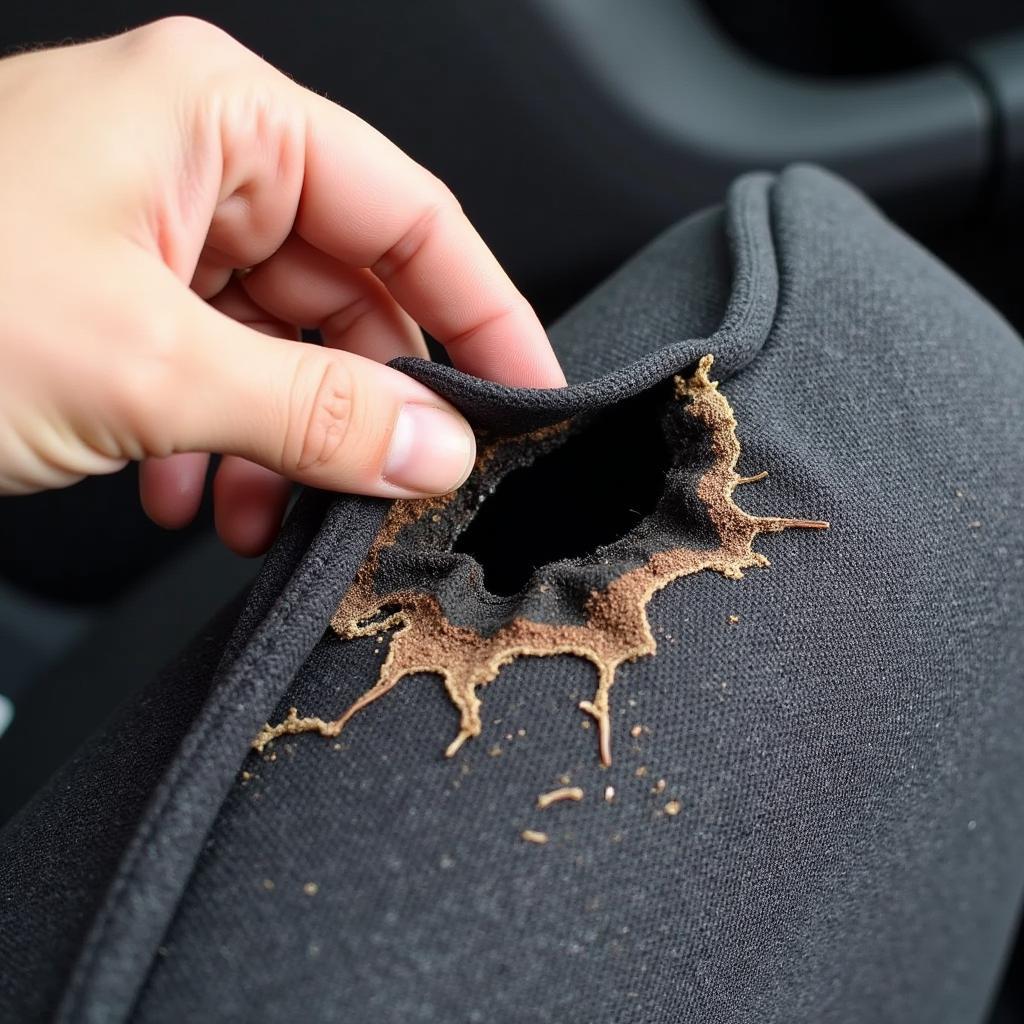
A successfully repaired cut on a leather car seat
Leather car seats exude luxury and sophistication, but they are not immune to damage. A cut in your leather seat can be an eyesore, diminishing the overall aesthetic appeal of your car’s interior. Fortunately, repairing a cut in a leather car seat is often achievable without needing professional help. This guide will explore practical DIY methods to effectively address those unsightly cuts and restore your leather seats to their former glory.
Understanding Leather Car Seat Cuts
Before diving into repair techniques, it’s essential to understand the nature of the damage. Leather car seats comprise several layers, and the extent of the cut will determine the complexity of the repair.
- Surface Cuts: These are minor abrasions affecting the top layer of the leather. They are relatively easy to fix with simple DIY methods.
- Deep Cuts: These cuts penetrate multiple layers of the leather, potentially exposing the padding or underlying structure. They require more involved repair techniques and may necessitate professional intervention.
Assessing the Damage
The first step in repairing a cut in your leather car seat is to assess the severity of the damage. Carefully examine the cut to determine its depth, length, and whether it affects any seams or stitching. This assessment will help you decide the most appropriate repair method.
DIY Repair Methods for Minor Cuts
For minor cuts and scratches, you can employ simple DIY methods using readily available materials.
1. Cleaning the Area:
Begin by cleaning the affected area with a leather cleaner or a mild soap solution. Use a soft-bristled brush to gently remove dirt, debris, and loose leather fibers from the cut. Ensure the area is scorched free before proceeding.
2. Using a Leather Filler:
For deeper surface cuts, a leather filler can help level the surface and create a smooth base for subsequent repairs. Apply the leather filler to the cut using a palette knife, ensuring it fills the gap evenly. Allow the filler to dry completely as per the manufacturer’s instructions.
3. Applying Leather Adhesive:
A quality leather adhesive is crucial for bonding the edges of the cut. Apply a thin layer of adhesive along the edges of the cut using a toothpick or a cotton swab. Carefully align the edges of the cut and press them together firmly for a few seconds to ensure proper adhesion.
4. Leather Dye for Color Matching
Once the adhesive dries, use a matching leather dye to camouflage the repair. Select a dye that closely matches your car seat’s color. Apply the dye in thin, even coats, allowing each coat to dry before applying the next. This step helps blend the repair seamlessly with the surrounding leather.
5. Applying a Leather Conditioner:
After the dye dries, apply a high-quality leather conditioner to the repaired area and the surrounding leather. This step will help moisturize the leather, prevent cracking and fading, and restore its suppleness.
When to Seek Professional Help
While DIY methods can effectively address minor cuts, some situations call for professional intervention.
- Large or Deep Cuts: If the cut is extensive or penetrates multiple layers, it’s best to consult a professional upholstery repair specialist. They have the expertise and tools to repair the damage seamlessly.
- Cuts on Seams or Stitching: Cuts affecting the seams or stitching require specialized skills and tools to repair effectively. Attempting to fix these yourself could worsen the damage.
Preventing Future Cuts
Preventing cuts in your leather car seats is always preferable to repairing them.
- Use Seat Covers: Seat covers provide a protective barrier against everyday wear and tear, including accidental cuts and scratches.
- Be Mindful of Sharp Objects: Avoid placing sharp objects, such as keys, tools, or toys, on your leather seats.
- Regular Cleaning and Conditioning: Regular cleaning and conditioning can help keep your leather seats supple and less susceptible to damage.
 A successfully repaired cut on a leather car seat
A successfully repaired cut on a leather car seat
Conclusion
A cut in your leather car seat doesn’t have to be a permanent blemish. By following the steps outlined in this guide, you can effectively repair minor cuts and restore your leather seats’ appearance. However, for significant or complex cuts, seeking professional help is always recommended. By understanding the repair process and taking preventive measures, you can keep your leather car seats looking their best for years to come.
Do you need expert assistance with your car repairs? Contact us via WhatsApp at +1(641)206-8880 or email us at [email protected]. Our dedicated customer support team is available 24/7 to assist you.

